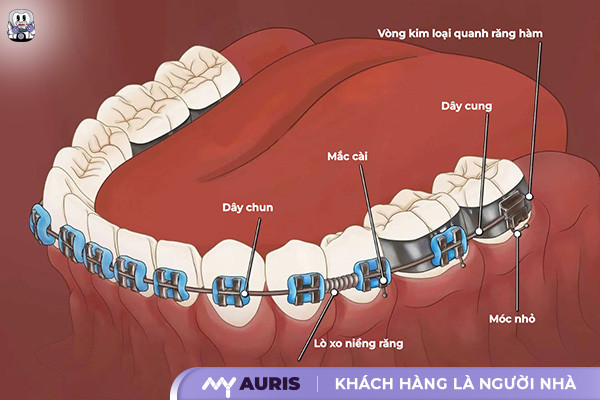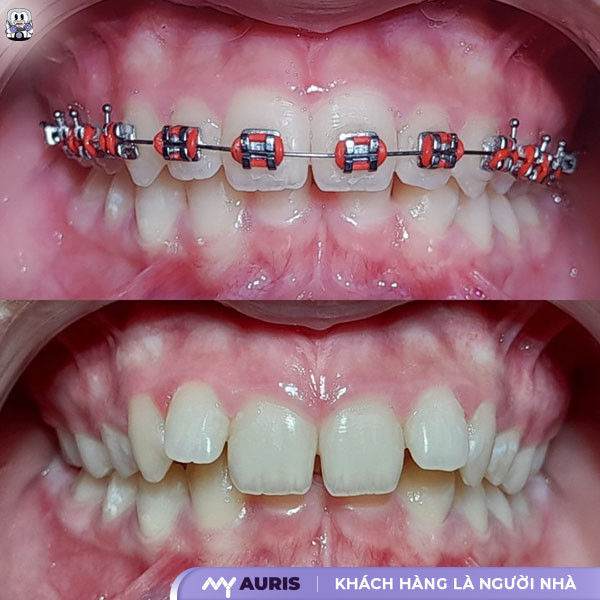Orthodontics is a complex physiological process that not only adjusts tooth positions but also facilitates the mechanism of tooth movement in braces through tissue and jawbone remodeling. Biological and mechanical factors directly impact treatment effectiveness. My Auris will provide in-depth analysis to help you understand better.
Mechanism of Tooth Movement During Orthodontic Treatment
In the field of orthodontics, understanding the mechanism of tooth movement not only helps dentists plan precise treatments but also helps patients comprehend why orthodontic forces can change tooth positions over time. In fact, biological changes occurring in the anatomical structures around the teeth are key factors in achieving effective orthodontic treatment.
A unique aspect of biological tooth structure is that teeth are not directly attached to the jawbone, but rather through a fibrous periodontal joint – also known as the joint between the tooth and the alveolar bone. This joint is formed from three main elements: cementum, periodontal ligament, and alveolar bone.
Cementum is a layer of mineralized tissue covering the tooth root. Although it contains no blood vessels, it plays a role in stable adhesion. Due to its unchanging nature, it is the most stable component when teeth are subjected to tensile or compressive forces during orthodontic treatment.
The alveolar bone consists of two layers: the outer layer is compact bone (cortical plate) and the inner layer is spongy bone. This is the region where bone resorption occurs on the compression side and bone formation occurs on the tension side – an essential biological process for effective tooth movement.
The periodontal ligament is a specialized connective tissue approximately 0.5mm thick, located between the cementum and the alveolar bone. Its main components are collagen fibers, along with connective tissue cells, blood vessels, nerves, and interstitial fluid. It is considered a “biological sensor” that helps detect and adjust the forces applied to the teeth.

Types of Tooth Movement in Three-Dimensional Space
In orthodontics, tooth movement is not merely a change in position but a process where teeth move in three-dimensional space with various forms of motion. A clear understanding of each type of movement helps orthodontists create accurate treatment plans, effectively control both translational movement and tooth rotation during braces, and prevent unwanted movements.
Translational Movement
This type of movement occurs when the entire tooth – from crown to root – moves in the same direction and at the same speed. Since no rotation occurs, the center of rotation is considered to be at infinity. This helps achieve uniform tooth movement, especially when using forces from archwires and brackets customized for each patient.
Tooth Rotation in Braces
Rotational movement occurs when a tooth rotates around its center of resistance – the point where force does not cause a change in position. In the case of uncontrolled tipping, when the applied force only causes the crown to move out of alignment with the root, the tooth will rotate around a center of rotation near the apex. Conversely, controlled tipping is designed by combining force and rotational moment to rotate the tooth around a center of rotation precisely located at the root apex.
Root Movement
When the center of rotation is near or at the incisal edge, the tooth undergoes movement where the root part moves more than the crown. This technique requires meticulous adjustment in the archwire and bracket system, especially in cases where the long axis of the tooth needs to be corrected.
Intrusion and Extrusion
Two forms of tooth movement along the long axis are intrusion (the tooth moves into the bone) and extrusion (the tooth moves out of the gum). Since there is no rotation, the center of rotation is also at infinity, and this movement is controlled by axial forces, requiring the appliance system to be customized to avoid affecting periodontal tissues.

The Process of Tooth Movement During Braces
When you begin orthodontic treatment, you will go through a process of tooth movement in several different stages. This is a journey that requires time, patience, and strict adherence to the treatment plan from the orthodontist to ensure effective results in both dental aesthetics and chewing function.
Stage 1: Alignment of Crooked and Crowded Teeth (First 2 – 6 Months)
In the first stage, brackets, archwires, or aligners will apply even forces to each tooth, gradually moving crooked, crowded, or rotated teeth into their correct positions on the dental arch. This is the stage with the fastest tooth movement.
Patients may observe clear changes such as spaces appearing between teeth, and misaligned teeth being straightened, contributing to improved facial aesthetics and chewing function. However, feelings of tightness, mild pain, or loose teeth are normal physiological reactions, indicating that the teeth are adapting to the applied forces.
Stage 2: Tooth Axis Adjustment and Jawbone Improvement (Next 3 – 6 Months)
At this point, the speed of movement slows down, and the treatment focus shifts to adjusting the tooth axes, ensuring that teeth are not only aligned but also have the correct angulation. Conditions like overbite and underbite are also significantly improved.
As teeth move into their correct axes, the jawbone gradually changes in a positive direction, leading to a more balanced and harmonious facial appearance. During this stage, orthodontists often update the treatment plan based on the actual response to optimize orthodontic results.
Stage 3: Bite Completion and Chewing Function (6 – 9 Months Later)
Once the teeth are nearly in their desired positions, the goal at this point is to achieve a perfect bite. The orthodontist will finely adjust the forces from the braces so that the upper and lower jaws fit snugly together, creating stability during chewing and preventing temporomandibular joint (TMJ) disorders.
This is an extremely crucial step to ensure that after removing braces, you not only have beautiful teeth but also efficient and long-lasting chewing function.
Stage 4: Stability Maintenance and Relapse Prevention (Final 6 – 9 Months)
After completing the main orthodontic steps, the orthodontist will prescribe the use of retainers to keep the teeth fixed in their new positions. At this point, periodontal tissues and bone around the teeth need time to remodel, preventing relapse, which means teeth shifting back to their original positions.
Retainers can be fixed or removable, and the wearing time usually lasts from 6 months to 1 year, depending on the individual’s constitution and the level of stability. Failure to wear them as prescribed can negate all previous orthodontic achievements.

Factors Affecting Tooth Movement Mechanism During Braces
To achieve maximum effectiveness in orthodontic treatment and minimize complications, orthodontists need to comprehensively evaluate various physiological and environmental factors that impact the mechanism of tooth movement.
Orthodontic force determines the speed and effectiveness of tooth movement. If the force is too light, the orthodontic process will be prolonged, while if it’s too strong, it can lead to consequences such as root resorption, gum recession, periodontal tissue damage, and even affect the alveolar bone. Therefore, customizing the appropriate force for each patient is essential in the treatment plan.
Applying light but consistent force is considered ideal to support bone regeneration, facilitate physiological tooth movement, reduce pain, and prevent tissue damage. Conversely, intermittent or too infrequent forces will affect the tooth movement mechanism, reducing orthodontic effectiveness.
The alveolar bone serves as the supportive foundation for teeth. Patients experiencing bone resorption around the tooth roots or bone loss will face many difficulties in tooth movement, leading to extended treatment times and potential risks of complications.
Age directly affects bone remodeling capability. In younger individuals, the body can respond quickly to forces, usually within 2–3 days. However, for older adults, the biological response time can extend to 8–10 days, requiring more flexible adjustments to the treatment plan.
Patients with jawbone structures featuring small pulp chambers and dense, thick cortical plates will experience more difficulty in tooth movement. This is a factor that needs to be carefully evaluated by the orthodontist before developing a specific treatment plan.
A complete nutritional regimen positively impacts bone regeneration and the maintenance of periodontal tissue health. Essential nutrients such as calcium, vitamin D, vitamin A, vitamin C, and protein play crucial roles in tissue repair and bone structure. Deficiencies in these substances can not only slow down the orthodontic process but also increase the risk of complications.
The orthodontic treatment process depends not only on the dentist’s technique but also on a complex interplay of factors such as orthodontic force, frequency of force application, alveolar bone condition, age, jawbone structure, and nutritional status. Understanding these factors helps orthodontists develop optimal treatment plans and achieve sustainable results for patients.





